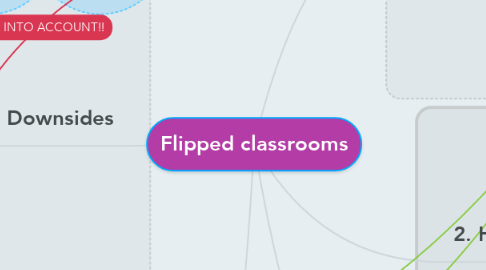
1. Must be corrected sooner.
2. 4. Downsides
2.1. TEACHER
2.1.1. Extra Time
2.1.2. Additional Work
2.1.3. New Skill to be acquired
2.2. STUDENTS
2.2.1. Lost of face-to-face lectures (complains)
2.2.2. tempted to skip class because "only" focus on activities
2.2.3. They don't find the value of the model (not useful)
2.2.4. May have problems with new technology
3. An effective Flip requires careful preparation
4. 5. Implications for teaching
4.1. TEACHER
4.1.1. BEFORE (Introducing F.C)
4.1.1.1. Teacher in front of the class
4.1.2. AFTER (Introducing F.C)
4.1.2.1. Teacher is collaborative and contributor
4.2. STUDENTS
4.2.1. Before (Introducing FC)
4.2.1.1. Passive Participants: Merely covering material
4.2.2. After (Introducing F.C)
4.2.2.1. They have responsibility for learning: working toward master of it.
5. No single model stablished! Up to teacher and moment of class or classes
6. 1. what is it?
6.1. At Home: short video lectures
6.2. In class: Projects, exercicies and discussions
6.3. BASED ON
6.3.1. Active learning
6.3.2. students engagement
6.3.3. hibrid: Podcasting & course design
6.4. VALUE: REPORPOSING THE CLASS
6.4.1. Student works on building knowledge
6.4.2. Teacher= coach, advicer, instructor...
7. 2. How it works?
7.1. PROCEEDINGS
7.1.1. Short video lectures
7.1.2. Quiz in class relating lectures
7.1.3. Clarification of confusing points
7.1.4. Debates lead by the teacher
7.1.5. Teacher suggests approaches to clarify new concepts
7.1.6. cooperative work acquire concepts
